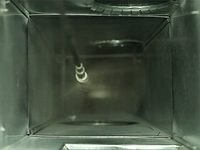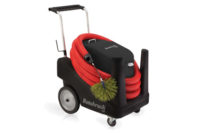The R&R Roundtable: Air Duct Cleaning in Restoration








No matter whether you have brought duct cleaning in house or sub it out to qualified contractors or professionals, a proper cleaning of the HVAC system is crucial to returning a mold infestation or fire/smoke damage job to pre-loss condition in most cases.
In order to give you a better well-rounded scope on the necessity of duct cleaning after certain losses, we reached out to the manufacturers involved in selling the equipment. See what Dave Hart (RamAir), Mary Dziak (Air-Care), Jimmy Meyer (Meyer Machine & Equipment) and Bob Elledge (Rotobrush) had to say about everything from duct cleaning’s importance to bringing it in-house vs. subbing it out to the importance of training:
Restoration & Remediation: When it comes to restoration, why is duct cleaning important?
David Hart: The HVAC duct system is essentially the lungs of the building. Since ducting nearly always runs throughout the entirety of the building, contaminates lurking there directly affect all areas of the structure’s interior.
If the duct system is not addressed in a restoration/remediation situation, as soon as the duct system is turned on, everything that was so meticulously cleaned and sanitized (i.e., carpet, walls, furniture, appliances, clothing) can now be re-infected, especially in mold and/or other microbial situations.
Mary Dziak: Air duct cleaning is important if you are remediating a home or facility - the air has been contaminated and it was being pulled by the air system. Cleaning the room and not cleaning the air ducts is doing half the job. Once the air system is run again, the room is re-contaminated.
Jimmy Meyer: HVAC air duct cleaning is an important step in the restoration process because the ducts are as much a part of the structure and living space as the drywall, roof deck, carpet, and frame construction. Ducts convey all the air in the building space, even when it’s dirty, smoky, moldy or filtered clean.
After restoration of mold, mildew and other microbial contamination, it is imperative ducts be cleaned to remove the spores and contamination that has been present in the conveyed air and dropped out of the airstream. Failure to clean ducts after a microbial contamination will result in the spreading of spores and future regrowth of microbial contamination.
During a structure fire, smoke, char and soot are distributed throughout the building through the ducts. Even in areas of the building that do not need other restoration services, the ducts likely have a buildup of soot and char. The smell of fire may continue for years in a building that has been restored, if the ducts are not cleaned and restored. Furthermore, smoke and heat damage passing through duct work can damage mechanical components causing them to fail, send improper signals or become disconnected.
Bob Elledge: Air ducts are easy to overlook since they are hidden, but it’s a key element in the cleaning process. When the HVAC system is operating, it circulates air throughout the air ducts into the various rooms of a business or home. Any remnants left in the air ducts could be transferred throughout the system and reenter the indoor environment. This becomes even more critical after fire, smoke or water-related damage. In addition to impacting indoor air quality, clogged air ducts can also force the heating and cooling system to work harder and less efficiently.
R&R: For a restoration business owner, what factors must be considered when weighing whether to sub-contract duct cleaning out or bring it in-house?
DH: Basically this comes down to calculating how much revenue you are/would be giving away to the sub-contracted duct cleaner vs. how much it would cost to buy your own equipment and pay your employees, or do it yourself. Figure how quickly you would recoup your initial cost, and the substantiality of the projected future generated revenue.
Figure the amount it would cost to equip yourself with duct cleaning and sanitizing equipment, and then how much revenue you will generate from the average duct cleaning job. This amount is usually a few to several hundred dollars for regular duct cleaning, and often twice that for restorative duct cleaning. I know of no other industry where start-up costs are recouped as quickly as they are in the duct cleaning industry.
MD: The business owner has to look at what his costs are associated with doing the duct cleaning in-house. That would include the cost of the equipment amortized over a certain length of time per job, labor costs and cost of goods (which is the chemicals and filters). If they look at their profitability after these costs and compare it to subbing it out, he can then decide how he wants to do it. It is possible that he take part of the money from the subs for just sending them the work also.
JM: Just like any proposal for business expansion, the costs and benefits should be considered when deciding to bring duct cleaning in house, rather than sub-contracting. In this industry, the demand for duct cleaning is high, and the cost is considerably low.
The return on investment of a duct cleaning business expansion can realistically achieve a profitable status after 3-6 months, considering the purchase of a professional equipment package, training and professional involvement.
BE: Often, the return-on-investment with duct cleaning equipment can be seen fairly quickly depending on demand for the service. There are many portable duct cleaning options available that do not require additional people onsite. Also, it is important to keep in mind that any employees using the air duct cleaning equipment will need to be thoroughly trained on the equipment and the duct cleaning process. If the budget, training opportunities or level of demand is low, then it may be best to hire a qualified contractor to provide the services. Either way, offering air duct cleaning can provide contractors with a competitive advantage.
R&R: For those wishing to bring the service in-house, what’s important to note when it comes to duct cleaning equipment?
DH: If you’ve decided that you’d like to bring duct cleaning onboard as a service, there are a few key points to consider when choosing your equipment: Effective - It is of utmost importance that the equipment you will be using performs the work thoroughly and completely. I cannot stress this enough. Simply put, your duct cleaning system should get the job done with flying colors. Time efficient - Time is money. You don’t want to spend all day doing a duct cleaning when it can be performed effectively in a few hours. Low maintenance - You want your equipment to be in the field making you money, not sitting around broken or in the repair shop. Simplicity - Your duct cleaning system should be easy to learn, and simple for you and/or your employees to operate.
MD: The business owner has to decide which method of duct cleaning he wants to perform or what is best for him. He then has to look at what is available, what training is available with the equipment, who does he want to train to do the work and how he is going to implement it. One of the first things he should think about is how he is going to get the customers. If he already has a customer base with his restoration company, that answer is easy - he should go after those customers first. When you have a relationship with a customer already, all you need to do is mention that you offer other services and most of the time they will want it done.
JM: When choosing to purchase equipment, three key factors are worth mentioning and are of equal importance: Vacuum/collection equipment, compressor/scrubbing/cleaning equipment and technician education.
As any of the above factors becomes stronger/better/faster, fewer of the other resources will be necessary to achieve the same desired result. For those new to duct cleaning, equipment will initially be the most important factor in a job well done. As an duct cleaner learns the trade, the level of service is usually increased and with better/newer/larger equipment purchases, the quality of service can be taken to the next level.
BE: Be sure to do research prior to purchasing the equipment. There are various types of equipment, so make sure to review your options and see what will be best for your company and your customers. It’s also beneficial to find a company that provides training courses so that contractors can feel confident speaking about the process and indoor air quality issues.
R&R: How important is proper training and technician know-how when it comes to duct cleaning?
DH: Having the best equipment and a ton of clients lined up is great, but like with everything in life, the technician needs to know what he or she is doing. Fortunately, duct cleaning is one of the easiest segments in the industry to learn. The system you buy should come with training materials, and they should be quick and simple to apply, not read like the instruction manual for a SpaceX Falcon 9 rocket. After all, duct cleaning is not rocket science- it’s basically turning a dirty tube into a clean tube.
Many duct cleaning manufacturing companies offer certification, and/or certification can be acquired through the National Air Duct Cleaner’s Association. NADCA is a valuable resource in the industry- you should make sure the manufacturer of your equipment is a member in good standing.
MD: Training is one of the most important factors of duct cleaning. There are different methods and different techniques involved. If the technician doesn’t have proper training, they can actually do more harm than good when performing the service.
JM: Training and technician know-how is imperative to successful service. Improper care for the HVAC system can result in wasted energy, hot/cold zones, pressure differential problems, IAQ problems or building performance degradation.
Training can be sought from some equipment suppliers as well as through the NADCA. Although there is a learning curve involved with HVAC air duct cleaning, the trade can be learned by many and a hardworking leader can easily become a skilled individual in the trade.
BE: Proper training of the equipment and the process is extremely important because inadequate training can result in releasing additional pollutants back into the air. All contractors should receive thorough training on the equipment and the most effective way to perform air duct cleaning.
R&R: Is there anything else you’d like to share about duct cleaning?
DH: High in demand, duct cleaning is the fastest growing segment in the cleaning industry. It’s also an essential (often required) service in disaster restoration/remediation jobs. With the economy on the fast-track to recovery from the recession, and duct cleaning being a surprisingly unsaturated industry (the demand for duct cleaning is high in relationship to the number of service providers), it is a very attractive add-on or standalone business opportunity.
MD: There are many duct cleaners performing services that are not doing it right. This could be because they are not getting enough money for the job and they are rushing through it or they just don’t know how to perform the job properly. Both of these can be overcome by simply getting the proper training on the procedures and also the marketing and pricing.
JM: Duct cleaning is definitely a trade that fits right into the restoration and remediation industry. Whether your company plans to bring the service in house to increase profits, maintain project control, increase brand awareness or continue sub-contracting, make sure that each restoration job you are involved with is completed with a cleaning as one of the final trades on-site, preferably from a NADCA member or another professionally qualified contractor.
Looking for a reprint of this article?
From high-res PDFs to custom plaques, order your copy today!











